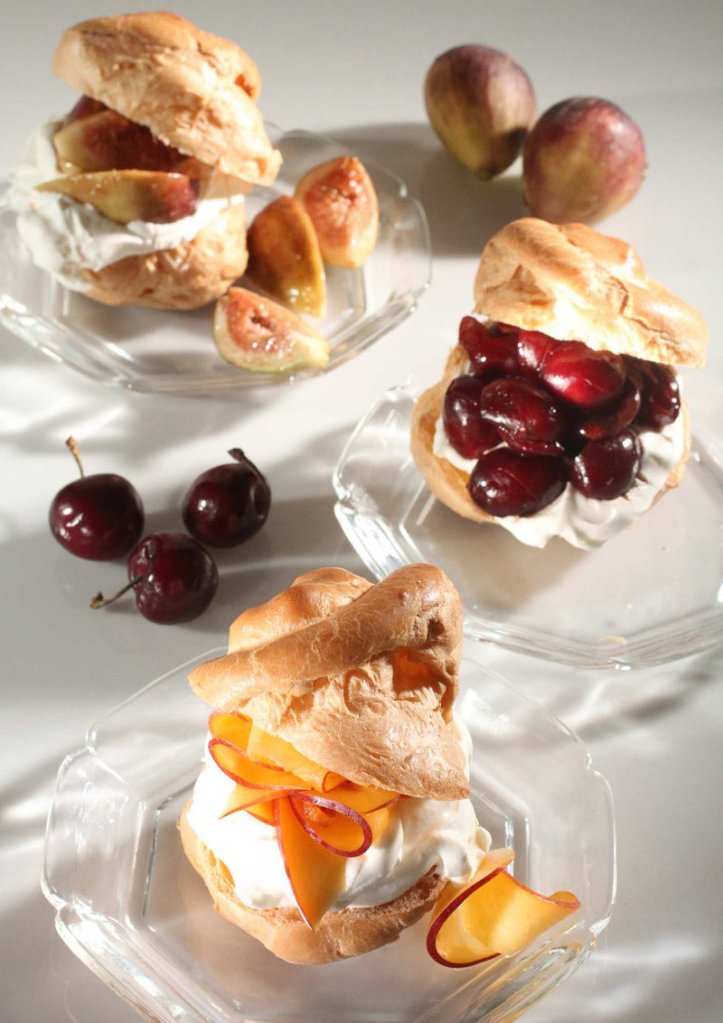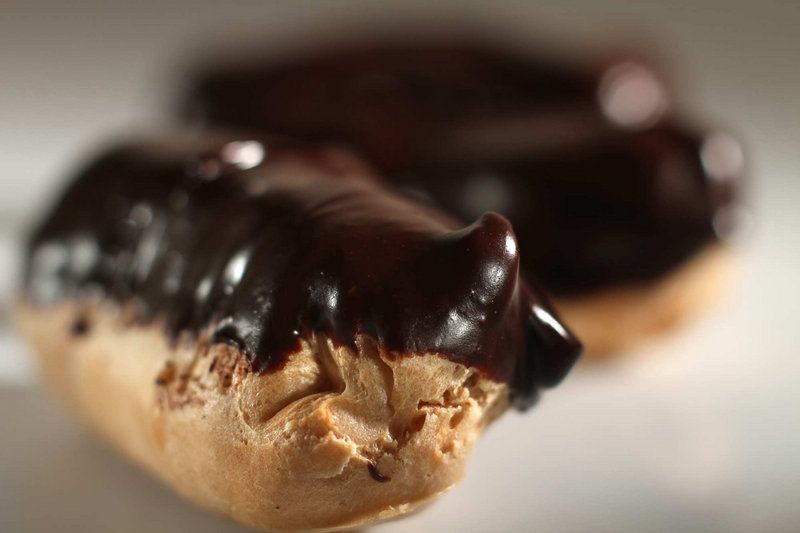Pate a choux is the stuff of magic in the kitchen. Pipe a soft, sticky dough onto a baking sheet and slide it into a hot oven. In mere minutes the dough puffs up – practically exploding to double, even triple, its original size – right before your eyes. Out of the oven, pate a choux cools to a golden-brown shell, crisp yet delicate and lighter than air. It’s downright mesmerizing.
Maybe you’ve never heard of pate a choux, but you’ve no doubt savored it at one time or another. Also known as cream puff dough, it’s the magic behind crisp eclair shells and towering cream puff pastries, savory profiteroles and cheesy gougeres.
Even better? Pate a choux is really simple to make. All it takes is butter, water, flour and eggs, perhaps a touch of sugar and salt, to get you started.
Combine water, butter, sugar and salt in a pot or saucepan. Bring the mixture to a boil, then add some flour. Stir the mixture quickly – this part of the recipe does require some elbow grease – to evenly combine the ingredients and hydrate the flour. Move too slowly and the flour will cook up in lumps, just like dumplings. Stir the mixture just a few minutes over low heat to cook out any extra moisture and develop the gluten needed for good structure.
As it’s stirred, the mixture will come together in a single mass, and you’ll notice a thin film forming on the bottom of the pan. At this point, it’s time to add the eggs.
Most recipes call for adding the eggs one at a time using a mixer or stirring by hand to properly develop the dough (simple as it may sound, constant stirring can really tone an arm). But for the best volume, skip the mixer and the workout, and pull out the food processor. I learned about the trick in Rose Levy Beranbaum’s classic “The Pie and Pastry Bible.” It’s the fastest and easiest method I’ve tried (all the eggs are added at once rather than one at a time), and it increased the volume of my pate a choux by a third.
And where most pate a choux recipes call for adding whole eggs, Beranbaum also mentions substituting some egg whites, something I’ve seen in a few other recipes, which helps to increase the overall structure and crispness of the baked pastry.
Use the pastries in a day or so, or freeze until you need them (they keep well frozen; simply refresh them in a warm oven). Fill them with pastry cream and top with chocolate glaze for eclairs, or stuff them full of chicken salad or a mousse for profiteroles. Adding grated cheese to the dough will give you classic gougeres, or be creative and fold other spices, even herbs or citrus zest, into the dough for other savory or sweet notes.
In the summertime, my favorite is a classic cream puff. Halve the puffs (I like mine on the generous side) and fill with freshly whipped cream. Spoon over fresh fruit – cherries, berries, figs, perhaps thinly sliced nectarine ribbons macerated with a little sugar and liqueur – and serve. It makes for a dramatic presentation – magical even.
PATE A CHOUX (CREAM PUFF PASTRY)
Start to finish: About 1 hour
Servings: 12 eclair or cream puff shells
Note: Inspired by a recipe by Rose Levy Beranbaum in “The Pie and Pastry Bible.” For savory pate a choux, omit the vanilla bean.
6 tablespoons (3/4 stick) butter, cut into ½-inch pieces and at room temperature
1 cup water
½ teaspoon salt
½ teaspoon sugar
Seeds from ½ vanilla bean
1¼ cups (5.3 ounces) flour
3 eggs
2 egg whites
1. Heat the oven to 400 degrees, and place a rack in the center of the oven. On a sheet of parchment paper, using a permanent marker, draw templates of the eclairs or cream puffs to help you pipe the batter. For the eclairs, draw 12 rectangles measuring 4 1/2 by 1 1/2 inches, spacing the rectangles about 2 inches apart (they will puff and spread as they bake). For the cream puffs, draw 2 1/2-inch circles, spacing the circles about 2 inches apart. Flip the parchment so the marker is on the underside of the sheet (you should still be able to see the templates), and place the parchment on a baking sheet.
2. In a medium-size, wide heavy-bottom saucepan, combine the butter, water, salt, sugar and vanilla seeds, and bring to a rolling boil over high heat. Remove from heat and stir in the flour (stir quickly or the flour lumps will cook). Return the pan to low heat and cook, stirring frequently, for about 3 minutes to cook the flour slightly and rid the mixture of any starchy, floury taste.
3. Remove the pan from the heat and place the dough in the bowl of a food processor or stand mixer. If using a food processor, process the dough for 15 seconds to cool slightly and release steam (leave the tube open), then add all of the eggs and egg whites at once. Immediately continue to process for 30 seconds to combine and form the batter. If using a stand mixer, beat the dough with the paddle attachment until most of the steam has subsided, then add the eggs and egg whites, 1 at a time, until each is incorporated and a batter is formed.
4. Remove the batter to a bowl set over an ice bath and continue to stir gently just until the batter cools slightly and thickens (it should be thick enough to hold its shape when piped).
5. Dab a little of the batter underneath the 4 corners of the parchment paper so it sticks to the baking sheet. Place the rest of the batter in a large pastry bag fitted with a large round tip (the hole should measure just over one-half inch in diameter).
6. Pipe the batter evenly onto the paper to cover each of the templates; the piped batter will rise about one-half inch off the parchment paper.
7. Place the sheet in the oven and bake for 30 to 35 minutes, until the pastry is richly golden and evenly colored on the sides and top, and is firm when tapped. Turn off the oven and place the handle of a wooden spoon in the door to keep it barely open. Leave the pastries in the oven for an additional 30 minutes to give them time to dry out and set up.
8. Remove the pastries and place them on a rack, leaving a little space in between each. Prick the side or underside of each with the tip of a paring knife or skewer, and set aside until the pastries are cooled to room temperature, then use or fill as desired.
Per serving: 118 calories; 4 gs protein; 10 gs carbohydrates; 0 fiber; 7 gs fat; 4 gs saturated fat; 62 mg cholesterol; 0 sugar; 125 mg sodium.
PASTRY CREAM (CREME PATISSIERE)
Total time: 20 minutes
Makes: 2½ cups
Note: This makes enough pastry cream to fill roughly 6 eclairs in the attached recipe.
3 tablespoons butter, cut into ½-inch pieces
2½ cups half-and-half
½ cup sugar
¼ teaspoon salt
1 (4-inch) piece split vanilla bean
2 eggs
2 egg yolks
¼ cup cornstarch
1. Place the butter in a strainer set over a medium bowl. Place the bowl over a larger bowl of ice water to form an ice bath.
2. In a medium, heavy-bottomed saucepan heated over medium-high heat, whisk together the half-and-half, sugar, salt and vanilla bean. Cook, striring frequently, until the mixture comes to a boil, 5 to 7 minutes.
3. Meanwhile, in a large bowl, whisk together the eggs, egg yolks and cornstarch.
4. Whisk one-half cup of the boiling half-and-half into the egg mixture to temper the eggs, then slowly stir the egg mixture into the hot liquid. Increase the heat to high and cook, stirring frequently (and scraping all sides and the bottom of the pan), until the mixture thickens and comes to a boil.
5. Immediately remove the pan from heat and pour the mixture over the butter in the strainer. Strain the pastry cream, then gently stir until the butter is completely incorporated.
6. Place a sheet of plastic wrap over the surface of the cream to prevent a skin from forming, and set aside until cooled. Use immediately, or refrigerate until needed.
Per ¼ cup serving: 185 calories; 4 g protein; 16 g carbohydrates; 0 fiber; 12 g fat; 7 g saturated fat; 105 mg cholesterol; 10 g sugar; 99 mg sodium.
CHOCOLATE GLAZE
Start to finish: 15 minutes
Servings: Makes about 2½ cups glaze
1 pound bittersweet or semisweet chocolate (chips or finely diced)
¼ cup (½ stick) butter
½ cup heavy cream
½ cup water
¾ teaspoon vanilla extract
2 tablespoons corn syrup
Pinch salt
1. Place the chocolate in a large bowl.
2. In a medium saucepan, combine the butter, cream, water, vanilla, corn syrup and salt. Bring to a good simmer over high heat. Remove from heat.
3. Pour the cream mixture over the chocolate and gently stir to combine, melting the chocolate and forming a glaze.
4. The glaze will thicken as it cools. The glaze will keep for up to 1 week, covered and refrigerated. Rewarm slightly to thin.
Per tablespoon: 81 calories; 1 g protein; 7 g carbohydrates; 1 g fiber; 7 g fat; 4 g saturated fat; 7 mg cholesterol; 4 g sugar; 5 mg sodium.
Send questions/comments to the editors.




Success. Please wait for the page to reload. If the page does not reload within 5 seconds, please refresh the page.
Enter your email and password to access comments.
Hi, to comment on stories you must . This profile is in addition to your subscription and website login.
Already have a commenting profile? .
Invalid username/password.
Please check your email to confirm and complete your registration.
Only subscribers are eligible to post comments. Please subscribe or login first for digital access. Here’s why.
Use the form below to reset your password. When you've submitted your account email, we will send an email with a reset code.